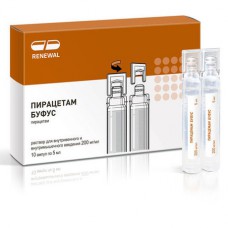Expiration date: 08/2030
Composition
1 solution contains:
active substance: piracetam - 200mg
auxiliary substances: sodium acetate, acetic acid diluted up to pH 5, 0-5, 8, water for injections
Pharmacological action
Piracetam activates in the Central nervous system associative processes, improves mood, memory and mentality of patients and healthy people. Stimulates intellectual activity and integrative activity of the brain, facilitates learning, improves communication between the cerebral hemispheres and the synaptic conductance in the cortex, improves mental capacity, stabilizes and restores the impaired functions of the brain (memory, consciousness, speech). Piracetam normalizes the ratio of ADP and ATP (inhibits nucleotidases and activates adenylate cyclase) that increases the activity of phospholipase A, stimulates in nervous tissue plastic and bioenergetic processes and metabolism of neurotransmitters.
Piracetam increases the stability of brain tissue to toxic effects and hypoxia increases the synthesis of phospholipids and nuclear RNA, enhances the glycolytic processes and the utilization of glucose in the brain. Piracetam inhibits platelet aggregation, improves microcirculation, optimizes the ability of erythrocytes to pass through the microvasculature and conformational properties of membranes of red blood cells in the ischemic areas of the brain increases regional blood flow. Piracetam increases in EEG alpha and beta activity and lower Delta activity. Reduces the vestibular nystagmus. During hypoxia, intoxication, trauma, electroconvulsive effects has a neuroprotective effect.
In connection with the anti-hypoxic effect of piracetam is effective in treatment of myocardial infarction. Anxiolytic and sedative effects of piracetam available.
Is almost completely and rapidly piracetam is absorbed after ingestion. The bioavailability is 100%. The ingestion of 2 g of the drug maximum plasma concentration is 40-60 µg/ml in 30 minutes. Piracetam is not bound to plasma proteins. Over 2-8 hours it creates the maximum concentration in the liquor. Piracetam penetrates into all tissues and organs, penetrates through the placental barrier. Almost not metabolized. Selectively accumulates in the cerebral cortex, mainly in parietal, frontal and occipital lobes, basal ganglia and cerebellum. The half-life of piracetam in plasma is equal to 4-5 hours; liquor is 6-8 hours. More than 95% of drug is excreted unchanged by the kidneys after 30 hours. In patients with renal insufficiency the elimination half-life increases.
Testimony
- Chronic cerebrovascular insufficiency (hypertension, atherosclerosis, vascular parkinsonism), which is accompanied by disturbance of attention, memory, speech, headache and dizziness;
- Ischemic stroke and its consequences.
- psycho-organic disorders;
- dementia (senile dementia, Alzheimer's disease, vascular dementia);
- traumatic brain injury;
- acute viral neuroinfection;
- intoxication (recovery period, coma and subcomittee state);
- diseases of the nervous system, which are accompanied by decrease in level of wakefulness, of intellectual-mnestic functions, behavioral disorders and emotional-volitional sphere;
- dizziness;
- vestibular nystagmus;
- sluggish-apathetic condition;
- aphasia;
- cortical myoclonia;
- epilepsy (as an adjuvant);
- senile and atrophic processes;
- depression resistant to antidepressant treatment;
- the prevention or elimination of neurological, somatic and vegetative, psychiatric complications of treatment with neuroleptics and other psychotropic drugs;
- neurotic depression with a predominance in the clinical picture, senesta-hypochondriacal and asthenic disorders, weakness, phenomena of ideomotor retardation;
- psychoorganic syndrome in chronic alcoholism;
- relief pre - and delirious, withdrawal state when drug addiction and alcoholism;
- acute intoxication by morphine, ethanol, amphetamine, barbiturates;
- in children with cerebral palsy, consequences of perinatal lesions of the Central nervous system, delayed mental development, low learning ability when psychoorganic syndrome, speech disorder, mental retardation, impaired memory, cerebrasthenia, intellectual insufficiency;
- sickle-cell anemia (in the complex treatment).
Method of application and doses
The drug is administered intramuscularly or intravenously.
The use of piracetam in adults:
In the treatment of cerebrovascular disorders in the acute Phase, the drug should be administered as early as possible, in the dose of 12 g per day for 2 weeks and then 4.8-6 g per day.
When cortical myoclonia treatment starts with a dose of 7.2 g / day every 3-4 days, increase the dose to 4.8 g per day until the maximum dose of 24 g per day 2-3 times per day, orally or parenterally. Every 6 months should reduce the dose by 1.2 g every 2 days.
Sickle cell anemia daily dose of 160 mg/kg, divided into 4 equal portions. During the crisis, and 300 mg/kg.
Alcoholism - 12 g / day in the period of manifestation of the syndrome of "cancellation" of ethanol; maintenance dose - 2.4 g
In the treatment of comatose States, posttraumatic initial dose - 9-12 g / day, supporting - 2, 4 g, course of treatment - 3 weeks.
Side effects
Nervous system and sense organs: hyperkinesis, drowsiness, irritability, depression, agitation, asthenia, aggressive behavior, dizziness, sleep disorder, headache, tremor, increase of sexuality;
Digestive system: nausea, diarrhea, vomiting, abdominal pain;
Metabolism: increased body weight;
The circulatory system: the aggravation of coronary insufficiency, arterial hypertension or hypotension;
Skin: hypersensitivity reactions.


